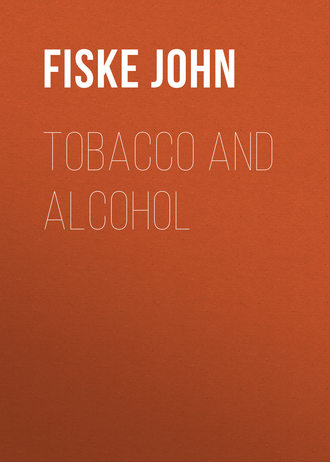 полная версия
полная версияTobacco and Alcohol
25
Mill's System of Logic, 6th ed. vol. I. pp. 503-508.
26
"The Puritans, from the earliest days of their 'plantation' among us, abhorred the fume of the pipe." Fairholt, Tobacco, its History, etc., p. 111.
27
Smoking has also been charged with acting as a predisposing, or even as an exciting, cause of insanity, – a notion effectually disposed of by Dr. Bucknill, in the Lancet, Feb. 28th, 1857. Before leaving this subject, it may be well to allude to Mr. Parton's remarks (p. 35) about "pallid," "yellow," "sickly," and "cadaverous," tobacco-manufacturers. He evidently means to convey the impression that workers in tobacco are more unhealthy than other workmen. Upon this point we shall content ourselves with transcribing the following passage from Christison, On Poisons, p. 731: – "Writers on the diseases of artisans have made many vague statements on the supposed baneful effects of the manufacture of snuff on the workmen. It is said they are liable to bronchitis, dysentery, ophthalmia, carbuncles, and furuncles. At a meeting of the Royal Medical Society of Paris, however, before which a memoir to this purport was lately read, the facts were contradicted by reference to the state of the workmen at the Royal Snuff Manufactory of Gros-Caillou, where 1000 people are constantly employed without detriment to their health. (Revue Médicale, 1827, tom. III. p. 168.) This subject has been since investigated with great care by Messrs. Parent-Duchatelet and D'Arcet, who inquired minutely into the state of the workmen employed at all the great tobacco-manufactories of France, comprising a population of above 4000 persons; and the results at which they have arrived are, – that the workmen very easily become habituated to the atmosphere of the manufactory, – that they are not particularly subject either to special diseases, or to disease generally, – and that they live on an average quite as long as other tradesmen. These facts are derived from very accurate statistical returns. (Annales d'Hygiène, 1829, tom. I. p. 169.)" The reader may also consult an instructive notice in Hammond's Journal of Psychological Medicine, Oct. 1868, vol. II. p. 828.
28
See Dr. Derby's pamphlet on Anthracite and Health, Boston, 1868; and an article by the present writer, in the World, April 11th, 1868.
29
The cigar is, however, usually made of milder tobacco. And an old pipe, saturated with nicotinous oil, may become far stronger than any ordinary cigar.
30
Tobacco, as we have said, may, in an adequate dose, produce well-developed paralysis. Whether the ordinary excessive use of it ever does cause paralysis, is, to say the least, extremely doubtful. Dr. D. W. Cheever says, "The minor, rarely the graver, affections of the nervous system do follow the use of tobacco in excess… Numerous cases of paralysis among tobacco-takers in France were traced to the lead in which the preparation was enveloped." Atlantic Monthly, Aug. 1860. Another instance of the great care needful in correctly tracing the causes of any disease or ailment. Lead-poisoning, when chronic, brings about structural degeneration of the nerve-centres.
31
Paraguay tea is used by 10,000,000 of people; coca by 10,000,000; chicory by 40,000,000; cocoa by 50,000,000; coffee by 100,000,000; betel by 100,000,000; haschisch by 300,000,000; opium by 400,000,000; Chinese tea by 500,000,000; tobacco by 800,000,000; the population of the world being probably not much over one thousand million. See Von Bibra, Die Narkotischen Genussmittel und der Mensch, Preface.
32
Omitting, of course, from the comparison, the class of diseases to which woman is peculiarly subject, as a child-bearer.
33
Opium, as used in moderation by Orientals, has not been proved to exercise any deleterious effects. Very likely it is a healthful stimulant; but it does not appear to agree with the constitutions of the Western races. See Pharmaceutical Journal, vol. xi. p. 364. Probably tea, tobacco and alcohol are the only stimulants adapted alike to all races, and to nearly all kinds of people.
34
Lewes, Life of Goethe, vol. II. p. 267.
35
In illustration it may be noted that as soon as a man has just transgressed the physiological limit which divides stimulation from narcosis, he is liable to throw overboard all prudential considerations and drink until he is completely drunk. This is one of the chief dangers of convivial after-dinner drinking.
36
For the physiology of this pupil-change, not uncommon in various kinds of acute narcosis, see the Appendix to Anstie.
37
Stimulants and Narcotics, pp. 174-178.
38
For this and parallel cases see Hamilton, Lectures on Metaphysics, Lect. XVIII.
39
It has been asserted by teetotalers that the mortality from intemperance is 50,000 a year in the United States alone!! It is to be regretted that friends of temperance are to be found who will persist in injuring the cause by such wanton exaggerations. In the United States, in 1860, the whole number of deaths from all causes was a trifle less than 374,000: the whole number of deaths from intemperance was 931, – that is to say, less than one in 374. See the admirable pamphlet by the late Gov. Andrew, on The Errors of Prohibition, p. 112. In view of these facts, it appears to us many leagues within the bounds of probability to say that hardly one person in ten is a
40
See Anstie, op. cit. pp. 215, 216, 218.
41
This is not always true, however: it is well to look sharp before making a sweeping statement. The digesting power of gastric juice is increased by diluting it with a certain amount of water. See Lehmann, Physiologische Chemie, II. 47.
42
Dunglison, Human Physiology, vol. I. p. 148; Lewes, Physiology of Common Life, vol. I. p. 170.
43
Dunglison, op. cit. I. 196.
44
Lewes, loc. cit.
45
A good summary will be found in the American Journal of Medical Sciences, July, 1859.
46
Chemistry of Common Life, vol. I., p. 288.
47
Except that of contemporary physiologists. Among these there are few greater names than that of Moleschott; whose testimony to the strengthening properties of alcohol may be found in his Lehre der Nahrungsmitiel, p. 162.
48
We presume Mr. Parton thinks these three unprofessional opinions enough to outweigh the all but unanimous testimony of physicians to the tonic effects of beer, wine and brandy.
49
Anstie, op. cit. pp. 381 – 385.
50
In view of these and similar facts, Dr. Anstie remarks that "the effect of nutritious food, where it can be digested, is undistinguishable from that of alcohol upon the abnormal conditions of the nervous system which prevail in febrile diseases." p. 385. For the use of wine or brandy in infantile typhoid and typhus, see Hillier on Diseases of Children, a most admirable work.
51
See Chambers, Digestion and its Derangements, p. 249; and in general, Johnston, Von Bibra, and the paper of Dr. Hammond above referred to.
52
Carpenter, Human Physiology, p. 387.
53
Anstie, op. cit., p. 359.
54
Baudot, De la Destruction de l'Alcool dans l'Organisme, Union Médicale, Nov. et Déc., 1863. See also the elaborate criticism in Anstie, op. cit., pp. 358-370.
55
De la Digestion des Boissons Alcooliques, in Annales de Chimie et de Physique, 1847, tom. xxi.
56
Ueber das Verhalten des Alkohols im thierischen Organismus, in Vierteljahrsschrift für die praktische Heilkunde, Prague, 1833.
57
See Moleschott, Circulation de la Vie, tom. ii. p. 6.
58
So decisive is the paralyzing power of a narcotic dose of alcohol upon the stomach in some cases, that we have seen a drunken man vomit scarcely altered food which, it appeared, had been eaten fourteen hours before. The sum and substance of the above argument is that, as the narcotic dose of alcohol prevents the digestion of other food, it will also prevent the digestion of itself.
59
In typhoid and typhus the "poison-line" of alcohol is shifted, so that large quantities may be taken without risk of narcosis. Women, in this condition, have been known to consume 36 oz. of brandy (containing 18 oz. of alcohol) per diem.
60
It is not certain, however, that alcoholic drinks, as usually taken, materially retard the waste of tissue. These drinks contain but from 2 to 50 per cent of alcohol; the remainder being chiefly water, which is a great accelerator of waste. The weight-sustaining power of brandy, or especially of wine and ale, can, therefore, perhaps be hardly accounted for without admitting a true food-action.
61
Dalton, Human Physiology, p. 363.
62
Payen, Substances Alimentaires, p. 482.
63
The liquid food may be taken in the shape of free water, or of water contained in the tissues of succulent vegetables. See Pereira, Treatise on Food and Diet, p. 277.
64
Physiological Memoirs, Philadelphia, 1863, p. 48.
65
Anstie, op. cit. p. 388.
66
Brinton, Treatise on Food and Digestion; and Cornhill Magazine, Sept. 1862; cited in the pamphlet of Gov. Andrew, above-mentioned.
67
Liebig, Letters on Chemistry, p. 454.
68
Anstie, op. cit. p. 401.









